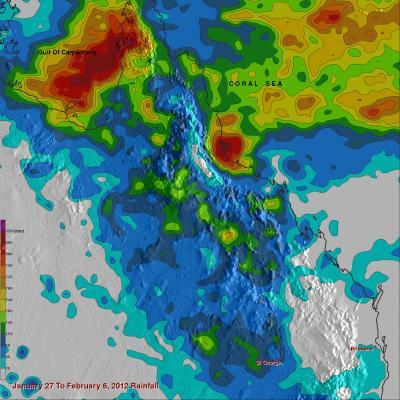A monsoon trough continues to drench northeastern Australia and NASA's Tropical Rainfall Measuring Mission (TRMM) satellite measured and calculated the rainfall in the region.
Low pressure centers associated with a summer monsoon trough have repeatedly drenched Australia from central Queensland to northern New South Wales. The clockwise rotation of these low pressure centers have continued to pump warm moist air from the Coral Sea over these areas resulting in severe flooding. Thousands of Australians have been displaced by this flooding.
A Tropical cyclone called Jasmine originated as a low pressure center over the Cape York Peninsula. Jasmine was upgraded to a tropical cyclone on February 6, 2012. Jasmine is in the Coral Sea well east of Australia, moving eastward and is predicted to strike Vanuatu on February 8th, 2012.

This is TRMM satellite rainfall estimates for the state of Queensland are shown above for the ten day period from Jan. 27 to Feb. 6, 2012. The highest amounts of extreme rainfall (shown in purple), totaling more than 520 mm (~20.5 inches), extend from the Gulf of Carpentaria over the Cape York Peninsula. This analysis shows another area south of Mackay along Australia's coast with rainfall totaling over 480 mm (~18.9 inches).
(Photo Credit: : SSAI/NASA, Hal Pierce)
Data from the TRMM satellite are used to calibrate rainfall data merged from various satellite sources. This TRMM-based, near-real time Multi-satellite Precipitation Analysis (TMPA) at the NASA Goddard Space Flight Center, Greenbelt, Md. is used to monitor rainfall over the global Tropics. TMPA rainfall estimates for the state of Queensland were calculated for the ten day period from January 27 to February 6, 2012. The highest amounts of extreme rainfall, totaling more than 520 mm (~20.5 inches), extend from the Gulf of Carpentaria over the Cape York Peninsula. This analysis shows another area south of Mackay along Australia's coast with rainfall totaling over 480 mm (~18.9 inches).
Parts of the town on St George in southern Queensland were advised to evacuate. Runoff from extreme rainfall has swollen the Balonne River.
Source: NASA/Goddard Space Flight Center